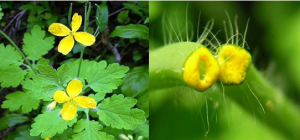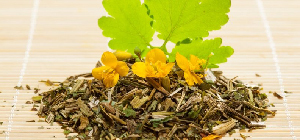In ancient Greece this plant was called swallow grass because it bloomed simultaneously with the return of birds from warm regions and bloomed on their departure. This herb was called "celandine" in Russia. The fact is that the juice of the plant perfectly copes with cleaning the skin from various age spots, acne, lichen, as well as warts, papillomas and genital warts.

Where do they come from: warts, papillomas, condylomas?
First of all, I have to say that the appearance of all these neoplasms on the skin or mucous membranes has no relationship with human age. Children, adolescents and adults are often faced with this problem. The fact is that warts, papillomas, and condylomas are infectious neoplasms that belong to the human papillomavirus (HPV), the papillomavirus family. Like any other virus or group of viruses, the human papillomavirus HPV (this is its other name) "loves" a weakened immune system. As soon as our immunity "weakens", as they say, it is right there. HPV is transmitted from person to person through direct contact, household items, sexual intercourse, childbirth, and other circumstances. The appearance of such neoplasms is often associated with neglect of the rules of personal hygiene.
Warts, papillomas and condylomas are predominantly benign neoplasms. However, there are different types of papillomavirus that can cause malignant neoplasms with low and high oncogenic risk. Before we use celandine, we need to be sure of what we are getting rid of. In any case, it is necessary to delete "good" forms, as over time they can become malicious, especially if they are injured, bruised, irritated, etc.
Warts, papillomas and condylomas differ in appearance and location.

What is celandine as a plant?
Greater celandine (Chelidonium majus L. ) is a perennial herb of the poppy family. Greater celandine contains a bright yellow-orange, milky juice. It blooms in May and ends in autumn. All parts of the plant are poisonous.
In almost the entire European part of our country, celandine grows like weeds. Small groups of this plant can be found under fences near residential buildings, in garden and summer houses, in city parks and in other places. Celandine is also grown. By the way, as a remedy for warts, celandine was introduced by colonialists to the United States in 1672 and distributed there to this day.
The chemical composition and medicinal properties of celandine
All plant parts contain alkaloids, saponins, organic acids (malic acid, citric acid, succinic acid), flavonoids, a small amount of essential oil, resinous substances, bitterness, carotenoids and ascorbic acid. Celandine seeds consist of around 50% fatty oil.
Alkaloids take first place in the chemical composition of celandine for a reason. There are more than 20 of them and that is why the plant is poisonous. To prove it:
- Chelidonin- an alkaloid, the structure of which is similar to morphine and papaverine;
- Homohelidoninis a convulsive poison and a strong local anesthetic;
- Heleritrinhas a local irritant effect;
- Sanguinarinhas a short-term narcotic effect with the occurrence of a special type of seizure;
- Protopinstrengthens the smooth muscles of the uterus.
However, if celandine weren't so poisonous, how would it have overcome our "favorite" viruses? By the way, the Latin word "virus" means "poison" or "poison principle". It turns out we can fight infection with the power of nature? In this case, YES. It really is. You only need a little effort and patience.
How does celandine work against warts, papillomas and genital warts?
Before the procedure, the growth of the skin is moistened with water. The top layer is then removed with a sterile cutting instrument. Then the celandine preparation is applied. This can be, for example, milky juice, tincture or oil based on this plant.
CLEAN MILK JUICE
Grass juice that has just been torn off is applied to the problem area several times a day. Depending on the type of neoplasm, its severity and other factors, treatment can last 1-2 weeks.
TINCTURE BASED ON THE CLEANER
About 2/3 of the celandine leaves are placed in glassware and filled with 70% medical alcohol. They insist in a dark place for 3 weeks. The problem area is treated with a ready-made tincture several times a day. If there are plantar warts, compresses are made on the feet (hold for 10-15 minutes). The course of treatment is 1 week.
CLEANING OIL
Celandine leaves are placed in a 0. 5-liter glass up to the shoulders and poured upwards with olive oil. They should be exposed to direct sunlight for 2 weeks with regular stirring. After that, the contents of the glass are filtered and used as compresses. The compress should be changed every 12 hours. The course of treatment is 1-2 weeks.

How do I collect and prepare celandine?
Experts recommend harvesting celandine during the flowering period. The best time is the second half of May and the first half of June. When collecting celandine, it is advisable to wear gloves and protective glasses. When collecting, it is essential to pay attention to the appearance of the plant: it should have a light green background without mechanical or chemical damage and also without traces of various diseases.
When collecting celandine, it is necessary to uproot the bush, clean the roots from the ground on the spot, and remove the stems from dry leaves and strange grass. At home, rinse the roots and stems, tie them loosely in bundles of 10-15 pieces and hang them to dry in a dry pantry on the balcony under a canopy in the shade with good ventilation. Can be dried in a dryer at 50-60 degrees.
When the grass is dry, collect it in a bundle, wrap it with paper or a dust-free cloth, leave the top of the bundle ajar for air, close the root system, and hang it on onedry place. So it can be stored for up to 3 years without losing its medicinal properties. Dried raw materials can be stored in well-sealed cardboard boxes in a dry, ventilated place.
Other useful uses of celandine

Since the healing power of celandine is also contained in its base and roots, you can collect it not only to get rid of warts, papillomas or genital warts, but also for other problems related to the condition of the skin and theMucous membranes connected from the outside are allowed from a specialist to apply it orally or locally according to recipes of traditional medicine or with the use of ready-made pharmaceutical raw materials. After all, this medicinal plant has an antimicrobial, antifungal, anti-inflammatory, anti-tuberculosis, immunosuppressive, calming, antispasmodic, analgesic, diuretic, choleretic, hypotensive, anti-allergic effect, etc.
On this basis, celandine is used for:
- Angina pectoris and hypertension;
- gastrointestinal and liver diseases;
- gout, rheumatism, polyarthritis;
- periodontitis;
- tuberculosis;
- various skin diseases;
- Colpitis, endocervicitis etc.
In the city's pharmacies you will find ready-made medicines made from celandine juice. There are also medicines that are alkaline-based cosmetic liquids, but aside from the name, these products have nothing to do with this plant. Be vigilant and vigilant when choosing medicines.
General contraindications for the use of celandine:
- increased sensitivity;
- bronchial asthma (BA);
- epilepsy;
- unstable angina;
- pregnancy and lactation;
- children (with caution).























